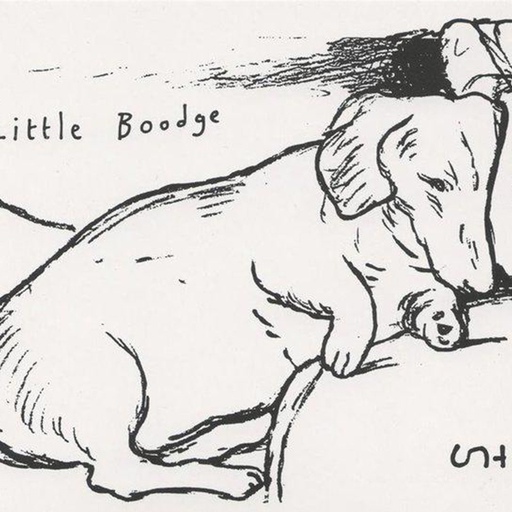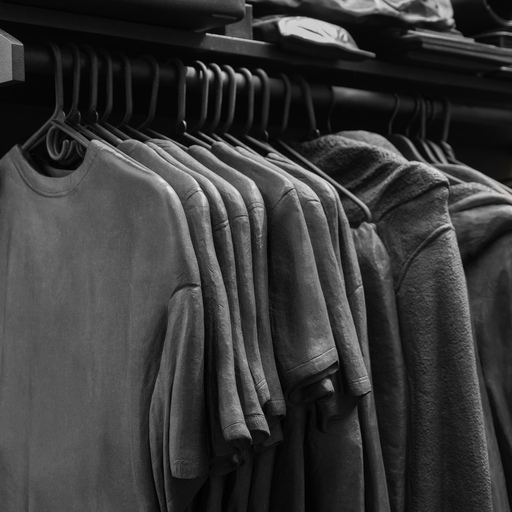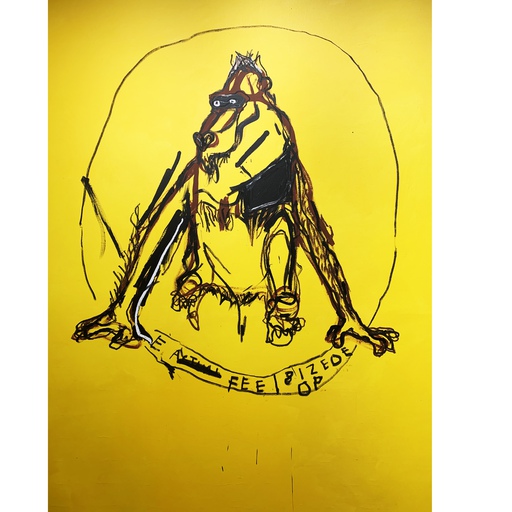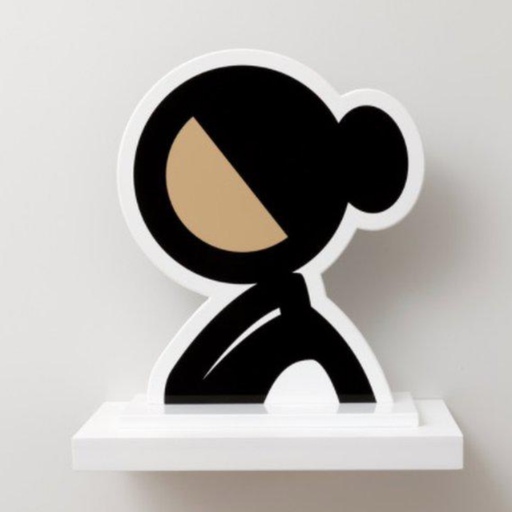Many great artists donated work to support the Merce Cunningham Dance Company over the years, often giving pieces that made reference to cherished experiences that the artists had shared with the dancers. To find out about the stories behind the artworks, Artspace editor-in-chief Andrew M. Goldstein spoke to Merce Cunningham Dance Company director Trevor Carlson about a few of the standouts.
To read a full interview with Carlson about Cunningham's legacy, click here.
Christian Marclay's Luzerner Theater, 1999/2006
Carlson: I love this Christian Marclay. He plays with sound in his work, and he performed with the company as a musician and then designed a set for one of Merce's one-night affairs that we had here in New York. But when he was touring with the company, he photographed one of the road boxes that we used for the sound equipment, which were always in the color of blue so that then they came off the trucks all the blue boxes would go to the music pit, all the red boxes would go to the wardrobe room, and all the green boxes would go to the side of the stage. So it was fun when he gave this to us because it was an instance of Christian's sense of humor in incorporating sound into a visual art medium that was quite personal to him and personal to us, too.
Robert Rauschenberg's Portrait of Merce, 1984
Artspace: This piece seems to be connected to Cunningham's famed 1958 dance Antic Meet, in which he danced with a chair tied to his back. Can you unpack this a bit?
Carlson:Antic Meet came out of an evening of music in New York in honor of John Cage that Jasper Johns and Bob Rauschenberg underwrote for Cage's 40th birthday, and on that evening Cage created what became the score for Antic Meet, called Concert for Piano and Orchestra. That score incorporated all of what Cage developed through his experimentation in developing sound—prepared piano, different types of notation, time-bracket notation—so it was kind of a retrospective of Cage's sound to date. Years later, when Merce made Antic Meet, he created a dance that was also sort of a self-retrospective. It incorporated his work with Martha Graham, his early Vaudeville years, tap, soft-shoe, ballet, drama, tragedy, and all the work that he'd been making up to that point. And it's not clear whether they ever discussed the fact that each of them was making their own retrospectives, but Rauschenberg did too, and his costume design and set design included a lace tablecloth, overalls, a white dress shirt with a black tie, a reference to his tire tracks through these tank tops that the dancers put on that looked like tires around the waist, sunglasses, an umbrella, light, light under the umbrella, parachutes. So all these things were incorporated for his costume and set design for the piece, and then in this print it seems he brought in some of those same elements: red was an important aspect of Bob's work—it was the most difficult color to work with, he said-and the cutout of the leger paper showed Merce's costume from Antic Meet, and there's a reference to the tires with the use of the tire spring, and his use of found objects with the broom. The basketball player is the most surprising part. I have no idea what it means.
Artspace: The picture of Cunningham dancing with the chair is one of the most famous images to come out of his work, photographed by a number of great photographers.
Carlson: Yes, many people took a picture of Merce with the chair. One person who photographed the chair was Andy Warhol, and Warhol made a silkscreen of Merce with the chair on his back, and the silkscreen was screened onto floral wallpaper. And when Merce's mother saw the Warhol—not really knowing who Warhol was and not really having understood what Merce was doing as a choreographer—she saw that it was a sheet of wallpaper, something that to her was quite functional in life, and said to Merce, "Finally, you've done something useful." Merce liked telling that story.
Rauschenberg's Cunningham Relief, 1974
Artspace:This piece here looks almost like Egyptian hieroglyphics, or an Egyptian frieze.
Carlson:It does, doesn't it? It was actually a poster design by Bob for the company, and the embossed bodies on three planes are portraits of dancers from Merce's work.
Rauschenberg's Poise, 1991
Carlson: This piece is really fantastic. At the top is a picture of a gorilla, but what I like better is the figure in the bottom right that Bob referred to as "the hoochie mama." It was this topless dancer, and here he has her head rolling off her torso.
Unnamed piece by Elaine de Kooning, date unknown
Carlson: Elaine and Bill [Willem de Kooning] were sent by John and Merce to teach at Black Mountain College one year when Merce and John, who had been there two years in a row to teach their summer program, couldn't return because they didn't have time. They recommended Bill and Elaine to go because they knew they needed the money. So there was a close friendship formed between Bill and Elaine and Bob and Jasper and John and Merce.
Merce Cunningham's Untitled (Melbourne 2007), 2007
Carlson: We were invited to do a performance series in Melbourne, Australia, over two weeks that involved exhibitions in two galleries and a museum, a 24-hour performance of Cage's work, an outdoor event by Merce, two repertory programs, and a series of music concerts by company musicians including Sigur Rós. These drawings were Merce's interaction with the Australian Print Workshop, which is the oldest print press in Australia, and he made these three great images for them. He never said exactly was that first one was—I think it's a cross between an ostrich and some kind of chicken. The middle one is another bird of some kind. And then he was so funny with the kangaroo, because he practiced and practiced drawing a kangaroo—he'd never drawn one before and he wanted to do one because it was Australia. He said, "The hardest part about a kangaroo is its tail, and the most important aspect for a kangaroo is its tail."
Artspace:Did Merce do a lot of his own art?
Carlson: Oh, yeah. Merce mostly did animal drawings, but he also liked drawing plants, and he was really intrigued by nature and really influenced by nature over his entire life in his drawings and his work. And every day he kept a journal in which he wrote on a single page. He wrote the date, the temperature wherever he was, where he was, and then a few words about maybe what had happened the night before and what he was thinking or doing that day. And then he also made a drawing. He drew these really wonderful, childlike depictions of different animals, and they were collected in a book called Other Animal.
Mikhail Baryshnikov's limited-edition photograph from 2008
Carlson:Misha started trying photography about 10 or 15 years before this was shot. He really enjoyed Merce's work, and in fact when his own company was in its early years he licensed one of Merce's dances to perform. He found me one day to see if it would be possible to come photograph Merce's work, because he was playing with the idea of leaving the aperture of his camera open and moving the camera so he could make the photograph appear to be in motion, and he thought he could do it with Merce's work because he felt it was constantly in motion—that there was no fixed image or pose in Merce's work. So he spent a number of years with us going on tour with the company and photographing the dancers and dress rehearsals, and he produced a book called "Merce My Way," and it's the way that Mischa sees Merce's dances. This was a limited-edition print that he donated to the company as a fundraiser.
Gabriel Orozco's Dot Ball, 1992/2006
Carlson: This Orozco is amazing-really a fantastic piece. It's a button on a piece of bark on the sand. Isn't that great?
Ernesto Neto's Untitled (Um Si Ho No Tiempo), 2006
Carlson: I wanted to use Ernesto Neto as a collaborator so badly in one of the events that we did, but his work was difficult because it was going to occupy the whole space and Merce liked to have the dancing range freely over the floor. But I just loved Ernesto's pieces with the spice in them and I was so excited by them, but I knew I couldn't convince Merce to accept one of those. So I put the idea in the back of my head and then later went to Merce to ask if he would considering doing something with Ernesto if I could get Ernesto to get his work off the ground. And Merce said, "Well, yes." So I met with Ernesto and talked with him about the possibility of doing something that didn't make contact with the floor. And he liked the idea and agreed and designed a work called Other Animal. Oh, that's funny—that's the name of Merce's book! It's a fantastic work, and it's actually on exhibit at the Walker. Anyway, I went to Brazil a few times to meet with Ernesto, and Ernesto also came here and met in Merce's apartment where we had dinner together a couple of times. And Ernesto said, "Well, you've seen my work—do you want to see my dancing?" And Merce said, "Oh, yes," and Ernesto did a little dance in Merce's apartment after dinner. This is a series of photographs of Ernesto doing the dance on the beach, in which he photographed himself dancing and the footprints he made in the sand while dancing.
Close Look
The Stories Behind the Merce Cunningham Collection Artworks



























